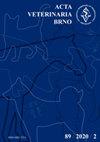Determination of African swine fever virus viability in meat during long-term storage and sous-vide cooking using cell culture and real-time PCR combined with palladium compound pre-treatment methods
IF 0.7
4区 农林科学
Q3 VETERINARY SCIENCES
引用次数: 1
Abstract
African swine fever virus is the causative agent of an acute and highly contagious disease affecting domestic and wild members of the family Suidae. The virus can be transmitted by direct contact among infected animals or via a contaminated environment or feed. Since the contaminated meat or products thereof have been characterised as the most probable vehicle in several outbreaks, the aim of the present study was to define viability of the virus in meat under conditions of freezing and chilling (−25 °C and 6 °C) and low temperature cooking (55 °C for 2.5 h and for 1 h). Two independent methods were employed; cell culture as a reference and real-time polymerase chain reaction combined with palladium compound (BB-PdCl2 and PdCl2COD) pre-treatment as an alternative method. Obtained results demonstrated a minimal decrease in the infectious virus titre during storage at −25 °C, and a remaining amount of viruses in meat stored at 6 °C for 14 months that can cause a disease after ingestion. The results obtained by both methods applied on the samples corresponded to each other. In contrast, results related to the virus’ persistence in thermal-treated meat indicated much lower stability than previously thought; infectious viruses were not detected by infectivity assay after the treatment at 55 °C for 1 h. The observed difference of one order of magnitude of virus detected using palladium compound pre-treatment suggests presence of intact rather than infectious viruses. A better suitability of PdCl2COD compared to BB-PdCl2 pre-treatment was demonstrated.采用细胞培养和实时PCR结合钯化合物预处理方法测定长期储存和真空烹调肉类中非洲猪瘟病毒活力
非洲猪瘟病毒是一种急性和高度传染性疾病的病原体,影响家养和野生猪科动物。该病毒可通过受感染动物之间的直接接触或通过受污染的环境或饲料传播。由于在几次暴发中,受污染的肉类或其产品被认为是最可能的媒介,因此本研究的目的是确定病毒在冷冻和冷却(- 25°C和6°C)和低温烹饪(55°C, 2.5小时和1小时)条件下在肉类中的生存能力。采用了两种独立的方法;以细胞培养为参考,实时聚合酶链反应结合钯化合物(BB-PdCl2和PdCl2COD)预处理作为替代方法。所得结果表明,在- 25°C保存期间,传染性病毒滴度略有下降,在6°C保存14个月后,肉类中剩余的病毒量可在食用后引起疾病。两种方法对样品的分析结果一致。相比之下,与病毒在经过热处理的肉类中持续存在有关的结果表明,病毒的稳定性比之前认为的要低得多;55°C处理1小时后,传染性病毒未被检测到。钯化合物预处理检测到的病毒差异为一个数量级,表明存在完整病毒而不是感染性病毒。与BB-PdCl2预处理相比,PdCl2COD具有更好的适用性。
本文章由计算机程序翻译,如有差异,请以英文原文为准。
求助全文
约1分钟内获得全文
求助全文
来源期刊

Acta Veterinaria Brno
农林科学-兽医学
CiteScore
1.00
自引率
33.30%
发文量
36
审稿时长
18-36 weeks
期刊介绍:
ACTA VETERINARIA BRNO is a scientific journal of the University of Veterinary and Pharmaceutical Sciences in Brno, Czech Republic.
The scientific journal Acta Veterinaria Brno is dedicated to the publication of original research findings and clinical observations in veterinary and biomedical sciences. Original scientific research articles reporting new and substantial contribution to veterinary science and original methods that have not been submitted for publication elsewhere are considered for publication. A written statement to this effect should accompany the manuscript, along with approval for publication by the author´s head of department. The authors bear full responsibility for the contents of their contribution. Book reviews are published, too.
 求助内容:
求助内容: 应助结果提醒方式:
应助结果提醒方式:


